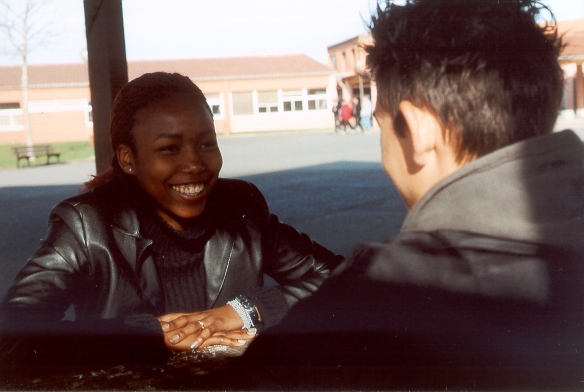Übersicht des Interkulturellen
Youth Politics. A Panel Discussion
The trait d’union file storage
The trait d’union profile in five languages
trait d’union - Idee, Konzeption und Projektstruktur
Projekte: Idee und Konzept; Evaluation, Analyse und Nachhaltigkeit
About Commenting. An Outline of a trait d’union Tutorial
Use “trait d’union” for your educational purposes!
Flucht & Heimat
trait d’union: on two pages / auf zwei Seiten
Wie AfD und Pegida ticken: Musterprojektion statt Mustererkennung
Angekommen – aufgenommen? Zur schulischen Integration von Migrantenkindern
Interkulturelle Integration als Bildungsaufgabe
Wirtschaftskultur bzw. Interkulturalität im Bereich der Ökonomie
Intercultural competence learning: from “trait d’union” through to the Intercultural Driving Licence
What you see is what you are prepared to see.
Intercultipedia: Wiki for Gathering Descriptors of Intercultural Competence (Draft)
Intercultural Competence and its Certification
Die Polyvalenz des „trait d’union“-Projekts als Basis seiner Multikompatibilität und Nachhaltigkeit
Interkulturelles Lernen in Schule und Unterricht
“trait d’union” offers facilities for intercultural communication and its learning.
“Trait d’union – Bindestrich zwischen den Kulturen”, präsentiert in der Zeitschrift BEGEGNUNG (2012)
“trait d’union” - a learning and action platform for intercultural involvement
Migration and Integration
Die internationalen Treffen der “trait d’union”-Redakteure: Schüleraustausch als Projektarbeit
Plädoyer für ein Internationales Zentrum für InterKulturelles Lernen in Colomiers (2002)
“trait d’union” präsentiert zweisprachig den deutschen Schriftsteller Matthias Politycki (2001)
Die “trait d’union” Webseite, ein multimediales Forum des interkulturellen Lernens und Austauschs
Die “trait d’union” Ausgaben von n° 1/2001 bis n° 10/2019
Programmatische Texte über die internationale Schülerzeitung “trait d’union” (2001-2012)
Europäische Projekte zum interkulturellen Lernen (seit 2000)
Dove est Faustina? Ein trilinguales Schüleraustausch-Projekt in Rom (1999)
Interkulturelles Lernen im Schüleraustausch (1997)
Vorschläge zur Didaktik, Methodik und Organisation einer Auslands-Studienfahrt (1992)
Interkultur
“trait d’union” offers facilities for intercultural communication and its learning.
By Lothar Thiel

Designed to support the cooperation between the students and teachers of the German School in Toulouse (DST) and the Lycée Polyvalent International “Victor Hugo” de Colomiers/France (LPI), the international school magazine “trait d’union” (hyphen) focussed from the beginning in 2000 on the topic of intercultural communication. “trait d’union” was the consequence of the “Goethe-Rallye”, a trilingual students’ exchange project, conducted in 1999 at Rome, in which intercultural communication played a decisive role.
In the first years of the “trait d’union” project, intercultural communication has been practiced within the weekly meetings of the common editorial staff of DST and LPI students at Colomiers and during the international project reunions (within the framework of student exchange).
Only since 2004, when Patrick Blitz, a student of the Michaeli-Gymnasium München, created the “trait d’union IntraNet”, the students of the member schools in different countries got a platform enabling immediate communication and cooperation not only during the international encounters, but also for the rest of the school year. This diversification of the “trait d’union” communications architecture - which was maintained and refined in the first “trait dunion Editorial Office” website (2009-2013) - allowed the students to discuss interesting topics and to exchange opinions, to comment on the articles of their colleagues in other countries and even to create common contributions.
An example: Maxi Geerds, Michaeli-Gymnasium München, “Maskenball” / “Die Entscheidung” (2006). The author used the IntraNet asking her colleages for their opinions about her story project. After a detailed discussion with students of Kraków, Toulouse and München, she wrote the final version, published in “trait d’union” n° 6/2006 “Courage”, p. 31-38.
The first “trait d’union Editorial Office” contained a lot of different groups. Some of them served to prepare the stipulated chapters of the following issue. As each member school had the responsibility for one or more chapters, this structure allowed a more regular distribution of tasks and at the same time it enabled the particular school to exert a greater influence on the magazine, because the school defined the contents and aims of the chapter for which it was responsible. This way the multicultural character of the magazine increased.
The acts of direct communication between the students of different school and countries were performed publicly, because the IntraNet and the Editorial Office allowed every Internet user in the world to observe the work in progress. And even in the “trait d’union” issues the dialogues between the editors were documented.
But the editors learned also, that the immediate communication contains the risk of conflicts because of individually, but particularly culturally different points of view. Sometimes they were poles apart! It was a big challenge for all: neither to brush the differences under the carpet, nor to menace the continued existence of the international team. So a profound reflection about ways of solidary and respectful criticism between members of an intercultural team became necessary. The following discussion, published in “trait d’union” n° 6/2006 “Courage”, p. 126-131, about “Turkey’s Accession to the European Union” shows the new dialogical style of “trait d’union” and the way how its editors discussed respectfully inspite of their deep divergences of opinion.
The common reflections about the courage to respectful criticism were also published in this issue (p. 134-135), being certainly an important element of intercultural competence.
Lothar Thiel: Cooperating by International Editorial Teams - IET (2010). This proposal was designed to motivate and intensify direct cooperation between the students of different countries during the project course, using the Internet (trait d’union Editorial Office) as well as working together at the project meetings. Depending on the teaching methods of the participating schools, project learning by IET can also be integrated in the subject teaching.
- - - - - - - - - - - - - - - - - - - - - - - - - - - - - - - - - - - -
Picture above: Marosia (LPI) & Achim (DST), Colomiers/France 2001
